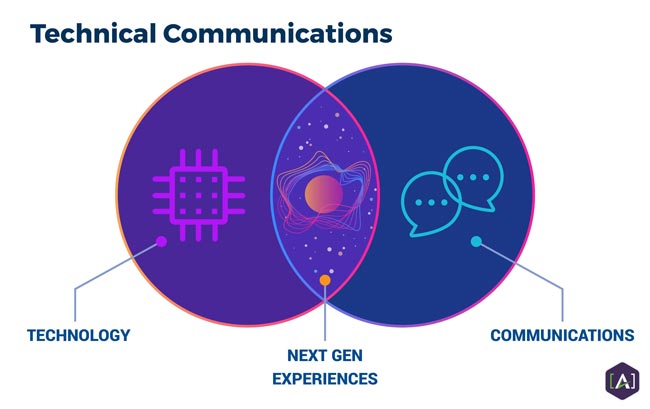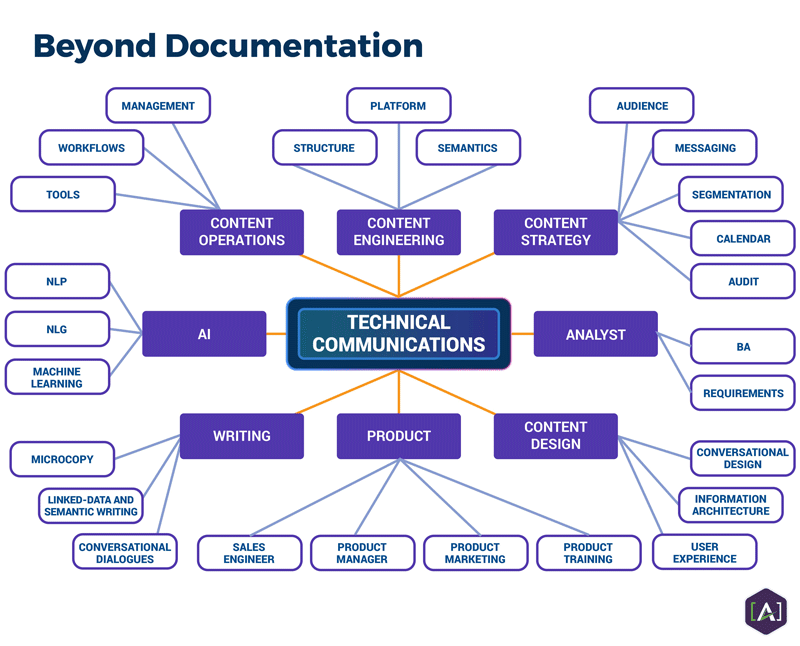Publishing teams across the enterprise stretch content creation and management in new directions daily. Multiple touchpoints on today’s dynamic customer journeys have nudged us towards intelligent content and omnichannel production. Enterprises face pressure to generate more flexible customer experiences that assemble content in response to a customer’s changing context. We call this Intelligent Customer Experience (ICX).
Customer journeys can start and transit to almost any touchpoint of customer-facing content. A purchase decision may start with voice assistance while walking, jump to a product video viewed on a smartphone at Starbucks, and continue with a brief session exploring customer reviews and support documentation on a tablet or laptop in the workplace. The customer interacts with a dazzling array of content types and channels as they interact with our organizations.
In order to survive and thrive in this new marketplace, we must shape our content and roles in totally new ways. We make content flexible enough to achieve real-time content personalization, which remains for most, a still-distant objective.
Enterprise publishers deliver personalized journeys not only via advanced tools and AI features, but by transforming “chunky” content management into fluid customer experience management. This requires engineering the content itself, and leans on the skills technical communicators have been building for decades.
Next-generation customer experiences (CX) require an expansive set of skills and instincts, ranging from the application of strategy and engineering thinking to content, to the active management of content structure and semantics. Technical communicators have been exercising many of these skills (especially structured authoring) for years. Techcomm is the logical pivot point to help create the future. Each professional in technical communications has tremendous career opportunities that didn't exist a decade ago.
Technical Communicators blaze the trail
Here at [A], we work with some of the largest and most complex publishers on earth, including many in the Fortune 50. Our clients work with content supply chains that cover various content sets, including marketing, technical communications, support, and in-product experiences to name a few. Basically, wherever we view content within an organization, we see the same ultimate challenges, except that technical communicators are ahead of the game. Critical next-generation experiences come out of this interplay between technology and communications that technical communicators have been navigating for several years. Since the advent of smartphones and conversational assistants, we've had to adapt to ever-changing channels of communication within our marketplace.

Connecting humans and machines together
Technology has become the intermediary by which we experience most transactions with a company, including pre-sales and post-sales. Technical communicators connect communications between humans and machines.
For years, many in technical communications have been structuring documents; be it with home-grown XML, DITA, or semi-structured approaches such as Word and Markdown formats. Everyone in techcomms understands the importance of tags and other associative metadata. Nowadays, many of the ‘documents’ we author are actually snippets and parts that become components in assembled experiences, which come together from disparate sources. Since sub-document level content has to go out to many different places, techcomm is leading the way due to the industry’s earned experience in omnichannel delivery over the past two decades. Many other departments within enterprise companies are still creating and managing content as unstructured “blobs” that are managed on a file-by-file basis.
Pathways beyond documentation
Content Services Organization: all of the disciplines and pathways we describe below are best orchestrated under a Content Services Organization (CSO), which is an orchestration layer for the application of standards and workflow among all different authoring groups, including techcomms. We must standardize content creation and delivery in order to dynamically reach more people in more places. A content services organization involves a lot of new roles that are beyond documentation, beyond marketing but are still within the realm of techcomm. You can find in-depth detail regarding the CSO and the standards and models it employs by downloading the “[A] Guide to The Content Services Organization”
The diagram below shows the many paths beyond traditional documentation that are now available to technical communicators who are ready to move into next-generation CX. These destinations are based on employment history that [A] derived from resumés. These paths all represent real people in the marketplace who have applied for a position in content engineering at [A], or that we have screened when helping clients to staff their new Content Services Organization.

From [A] experience, technical communicators are finding futures in expanded career tracks, including:
-
Content Operations: Tools, Workflows, Management
-
Content Engineering: Structure, Platform, Semantics
-
Content Strategy: Audience, Messaging, Segmentation, Calendar, and Audit
-
Analyst: BA, Requirements
-
Content Design: Conversational Design, Information Architecture, User Experience
-
Product: Sales Engineer, Product Manager, Product Marketing and Product Training
-
New Forms of Writing: Microcopy, Linked Data and Semantic Writing, Conversational Dialogues
-
Artificial Intelligence (AI): Natural Language Processing, Natural-Language Generation, and Machine Learning.
Here is a closer look at some of these practices through the lens of Content Operations, Content Strategy and Content Engineering. Together, they enable the bridge-building required in most organizations to free content from silos and render it more fluid.
Content Operations
Content Operations is how an organization performs day-to-day management of content. It is a chartered, permanent, cross-functional organization that contains functions that interact with and orchestrates various distributed authoring groups along with various stakeholder groups, like communities of practice, councils, and committees. For many organizations, this is still an aspirational goal. It is challenging to persuade someone to manage content at a structural level on an ongoing basis with a broad purview over interoperable content sets. Technical communicators have the ability to think in those terms of content operations, which help define and wire up content workflows and tools.
Content Engineering
Content engineering is the application of an engineering discipline to the design, acquisition, management, delivery, and use of content and technologies deployed to support a full content lifecycle. The practice of content engineering is content’s technical owner, the “CTO” of content.
- Structure: We need to be able to create variability by structuring content so it can be adapted to different user contexts out to different presentations.
- Semantics: Semantics is the contextualization of our content structures. It defines the entities and associations and relationships for a given piece of content, usually within metadata or a relational database or a graph database. Semantics is how machines can understand content, connections, and relationships. For example, it would determine how a piece of content can be associated with the segment it belongs to.
Content Strategy
The content strategist is the “CEO” of content, the role which directs the “who, what, when, where, and why” of content. In contrast, content engineers are focused on how content bridges gaps and makes the connection to channels and customers. Content strategy also establishes a business justification for investments made in improving how content is handled and defines the metrics that will be used to measure progress against that plan. This strategic mindset will be very familiar to long-time techcomm professionals.
Embracing New Forms of Writing
Writing itself is taking on new forms all the time. One clear example is writing for conversational interaction. How can we prompt, based on customer response, the right suggested next step via a chatbot or voice interface? For most, that was not even on our radar a decade ago. How do we write short, action-oriented responses for given intents? How can we bridge that short text form with traditional documentation?
However, what is old is new. Intent and response interactions are very familiar to techcomms professionals. Docs authors working in documentation know all about providing users with a series of ordered tasks in response to error state, based on the telemetry of a software application. Conversational interaction scripts are just introducing new containers, writing, and markup approaches to the kind of user education work technical writers have been doing since the dawn of the interface.
Now, all interfaces are moving towards some form of personalization. All of that is some form of contextual-based content that is being delivered, triggered by metadata. So, even if we remain within the writing side of techcomm, there are a lot of new and interesting opportunities.
For the most technically-minded who are familiar with structured content authoring, there are some really compelling career paths that involve making content sets available for Artificial Intelligence, working with natural language processing (NLP), natural language generation (NLG), and predictive forms of machine learning, designing ontologies, as an extension of where language meets technology. Making content meet intelligent systems is a journey the whole market is on, and many more leaders are needed.
Gaining the experience and skills to move forward
To achieve career success in this expanded array of services, we need structured authoring experience. If we don't have that first, we're not “there yet” in terms of a foundation for next-gen solutions. We also need to gain skills and experience with eliciting clear definitions within business requirements. Then, get experience generating modular presentations; this is essential for gaining funding support for a Content Services Organization from budget stakeholders.
It also helps to learn about object-oriented thinking if we don't have that in our repertoire. An object-oriented approach to organizing content requires reusable objects rather than hard coded unstructured blobs. It enables content containers to be pointed to and, from anywhere, manipulated, transformed, annotated, reused and managed from a central location. Metadata is essential to this process.
Technical communicators need to be object-oriented thinkers and need to be able to spread that DNA to other parts of the organization. Be proud of having a techcomm background. It’s a super power, indeed. Let’s get to work on making publishing smarter!
Ready for more? Check out [A]'s keynote on Intelligent Customer Experience, and view even more information about content intelligence, and how the practices of content strategy, content engineering, and content operations fit into a content intelligence framework.
Contact Us for a Free Consultation.